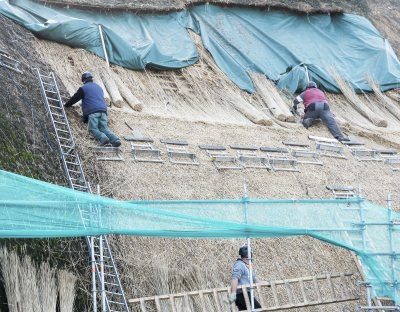Sector reaches agreement on new KOMO Assessment Guideline 1512-1 Reed
August 14, 2019
Reed quality requirements regulated by KOMO Assessment Guideline 1512-1
Reed is still regularly used as thatching material on roofs, facades and mills. This certainly applies to the restoration sector too. However, up until now universal quality criteria for the product reed, on which a KOMO product certificate can be based and issued, had been unavailable. This is about to change now that the reed sector (reed growers, thatchers and traders) has reached agreement on the Assessment Guideline 1512-1 ‘Reed for roofs, facades and mills’.
The Assessment Guideline 1512-1 includes the public and private requirements on reed that is used for the applications mentioned. Aspects include the moisture level and product flexibility, the possible presence of moulds and the extent to which the reed contains weed-like plant material. It is of course also described how the product must be tested by an independent certification body under licence from KOMO to determine whether it is sustainable and meets all criteria. The Assessment Guideline is supported by 11 relevant authorities and companies in and around the reed sector.
Scientific Substantiation
Pursuant to BRL 1512-1, the Board of Experts conducted extensive research into the possibility of allowing the sodium content of reed to be included in the set of quality requirements. This aspect is not part of the Assessment Guideline since, unlike the other criteria, no scientific substantiation was found for the assertion that sodium plays a role in the quality of reed.
“Assessment Guideline 1512-1 provides certainty and that will be of great importance, especially soon under the Building Quality Assurance Act (Dutch: Wkb),” says Oscar van Doorn, director of the SKH foundation (wood inspection agency) .
KOMO certification based on Assessment Guideline 1512-1 Reed
The SKH scheme manager sees the KOMO product certificate (based on Assessment Guideline 1512-1 Reed) for roofs, facades and mills as a boost for the reed sector, the building sector and for the restoration sector in particular. “After all, the KOMO product certificate based on Assessment Guideline 1512-1 provides certainty and that will be of great importance, especially soon under the Building Quality Assurance Act,” says Oscar van Doorn, SKH Director.
The KOMO Quality and Assessment Committee handled the Assessment Guideline 1512-1 for admission and also submitted a request for advice on monumental buildings to the ERM foundation’s Central Board of Experts on Restoration Quality.

